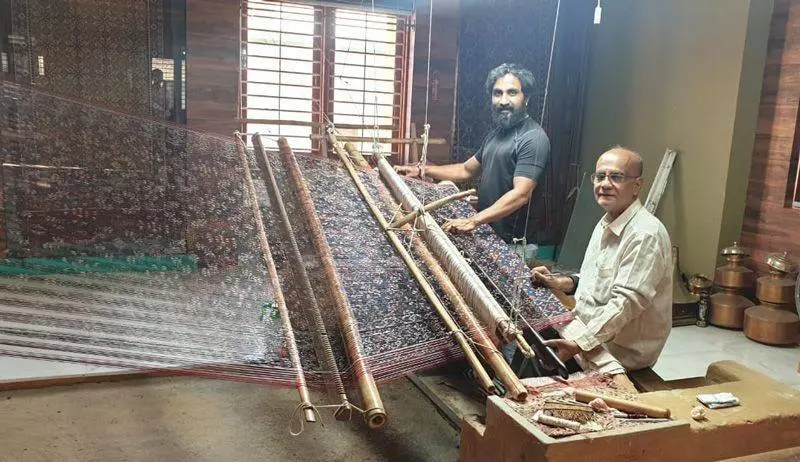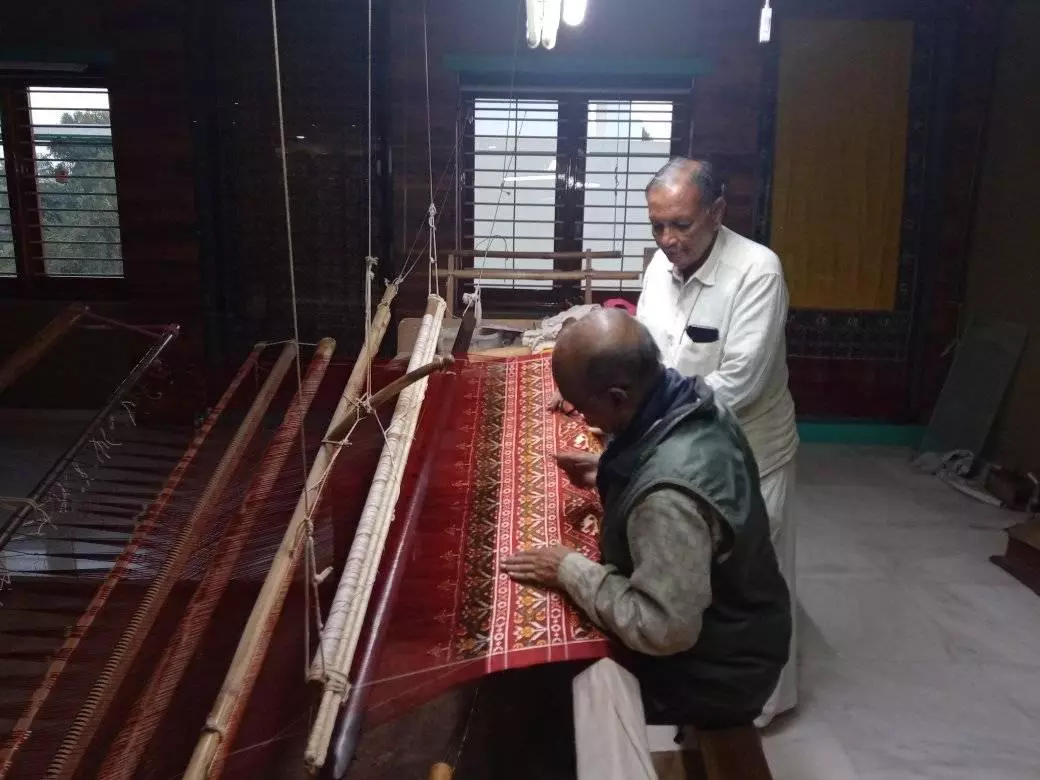
- Home
- India
- World
- Premium
- THE FEDERAL SPECIAL
- Analysis
- States
- Perspective
- Videos
- Sports
- Education
- Entertainment
- Elections
- Features
- Health
- Business
- Series
- In memoriam: Sheikh Mujibur Rahman
- Bishnoi's Men
- NEET TANGLE
- Economy Series
- Earth Day
- Kashmir’s Frozen Turbulence
- India@75
- The legend of Ramjanmabhoomi
- Liberalisation@30
- How to tame a dragon
- Celebrating biodiversity
- Farm Matters
- 50 days of solitude
- Bringing Migrants Home
- Budget 2020
- Jharkhand Votes
- The Federal Investigates
- The Federal Impact
- Vanishing Sand
- Gandhi @ 150
- Andhra Today
- Field report
- Operation Gulmarg
- Pandemic @1 Mn in India
- The Federal Year-End
- The Zero Year
- Science
- Brand studio
- Newsletter
- Elections 2024
- Events
Why the last Salvi family is failing in its fight to save dying Patola art

Rahul Vinayak Salvi left his lucrative profession as an architect in the US and returned to Patan district, his hometown in Gujarat, to join his family business in 2016. Forty-six-year-old Rahul is the 28th generation of the Salvi family who have been into weaving Patola silk saris.“Our younger generation is very well educated. There are architects, doctors and an engineer in our family,...
Rahul Vinayak Salvi left his lucrative profession as an architect in the US and returned to Patan district, his hometown in Gujarat, to join his family business in 2016. Forty-six-year-old Rahul is the 28th generation of the Salvi family who have been into weaving Patola silk saris.
“Our younger generation is very well educated. There are architects, doctors and an engineer in our family, but all of us are also master Patola weavers. Whatever we do, we will ultimately come back to practice our tradition of taking forward the Patola heritage. After all, our family was one of the 700 families that brought the traditional weave to Gujarat,” shares Rahul.
“Currently, nine members of my family are engaged in the business of weaving Patola. My father who currently heads the business, my mother, my brothers and their wives and my wife. Even our children visit the workshop to learn the craft,” he adds.
Patola’s past
The history of Patola weave dates back to the 12th century AD when King Kumarapala of the Chalukya dynasty of Gujarat invited a group of weavers from Jalna in Maharashtra. Initially, Patola is said to have been restricted as an attire of the royalty.
Legend has it that King Kumarpal was an art and culture connoisseur. It is said he believed that wearing a new Patola cloth each day would bring good fortune and prosperity. He was a Jain follower who would wear a new robe, or Patolu, every time he visited Jain temples. It is probably the reason why Patola is considered highly auspicious and when draped during important occasions, it is said to bring good luck. It is probably because of its ‘good luck charm’ that Patola is also kept in houses, usually framed, as a protective talisman.

Rahul Vinayak Salvi with his son.
The weavers were the Salvis who specialised in a special kind of weave on silk that later became popular as Patola.
“Salvi literally means weavers of silk. This has been the traditional occupation of the Salvis. Seven hundred families had shifted to Patan from Jalna accepting the invite from King Kumarapala who wanted a special fabric to make attire of the royal family. But we are the only Salvi family left to continue to keep this tradition alive. Others have quit weaving Patola and moved to various kind of textile businesses,” says 72-year-old Rohitbhai Salvi, who still sits on traditional loom at his home in Patan to weave the fabric.
The Salvi family home in Patan is also their workshop and another part of the home is a Patola museum that displays saris made by their family over generations, various awards and accolades.
The gloomy present of Patola
“We sit on the looms and weave ourselves and don’t hire workers from outside. We do not want to pass on the unique technique to anyone else as we are against commercialising the art. If you produce Patola in large numbers, the quality suffers. This has been our tradition for the past nine centuries, and 28 generations have worked against all odds to keep it alive,” says Rohit Salvi.
“Patola is woven on a primitive hand operated harness loom made out of rosewood and bamboo strips. The bamboo shuttle is made to move to and fro through warp shades. Each weft thread is examined thoroughly and matched with each part of the warp design pattern while weaving. It requires a lot of mental calculations, patience and dexterity of the hand. A computersied machine or power loom cannot be of much help here. The warp and the weft silk threads are tied separately,” Rohit Salvi explains.
“The threads have distinct knots of cotton, as per the design the weaver has composed. The knots help to keep that particular area unexposed while dyeing. The process of dyeing is repeated several times. First process is tying, then untying and retying and then dyeing over and over to dye in different shades and colours. After completing the dyeing process, we put together the threads of the warp in a sequence on the loop so the design becomes evident,” he adds.
“The resultant Patola silk has equal intensities of colour and design on both sides and it takes around six to eight months to make one sari. Owing to its process and time, the cost of a sari ranges from anything between Rs 1.5 lakh and Rs 5 lakh,” he adds.

A Patola silk sari can cost anywhere between Rs 1.5 lakh to Rs 5 lakh.
“Our art and perseverance have won us many awards and recognition, but our sale has gone down over the years as it is a costly item that a few can afford. Now we make saris on order basis and most of our order come from NRIs. Only a handful comes from those who can afford an original Patola. This is one the primary reasons why most of the Salvis have quit weaving for jobs or other businesses,” says Rahul Salvi.
Noticeably, as Salvis quit their traditional occupation, they left a vacuum that others rushed to fill in.
The fake
Shyam Soni’s is one such trader of Patan. The 32-year-old learnt the art from his father who had learnt it from one of the original Salvi families.
“My father started Madhvi Handicrafts 35 years ago. Today, we have 18 looms and 75 employees primarily weaving ikkat and double ikkat in Patola weave. But we use chemical colours and power looms that make the process faster and hence the saris are cheaper. Our saris range from Rs 10,000 to Rs 25,000,” says Soni whose company sells an average of three lakh faux Patola, or what are called imitation Patola saris, annually.
Maitik Khatri, a 42-year-old textile engineer is another Patan based textile weaver who makes imitation Patola. Khatri used his degree to introduce Patola weave on synthetic fabric in 2011 that not only slashed the price further but also considerably replaced the imitation silk patola saris.
“I studied textile engineering and came to Patan in 2011. My father had a textile business but it wasn’t doing well. I grew up in Patan and had always known about Patola. But original Patola is very expensive and hence has a very small market. Only the affluent can afford an authentic Patola sari. But there was demand for Patola amongst people who couldn’t afford an original sari. So, I began to manufacture ikkat and double ikkat Patola silk saris with some weavers who had worked with Salvi families. I used power loom and chemical dye that cut the price by more than half. In 2015, I introduced the weave on synthetic fabric cutting the cost further and making it more versatile. Now I make bags, shoes, dupatta etc using Patola weave. The price of my products ranges from Rs 100 for a bag, Rs 300 for a duppata and Rs 2,000 for a synthetic patola weave sari,” says Khatri.
Imitation Patola continues to thrive despite GI tag
In 2014, the Geographic Indication (GI) certification was handed over to the weavers of Patan patola saris, to safeguard their creations from duplication and ensure that no weavers other than Salvis can call their ikats Patan Patolas.
However, despite the tag, after over a decade, the Salvis feel sabotaged, as they claim that hasn’t stopped any textile trader of Patan from selling imitation Patola as ‘Patan’s Patola’.
“A variety of cheaper single and double ikkat version of weave is available in market that is being sold under the GI tag. The GI tag has hardly benefitted us. With a tag given to the whole region, any person could make and sell patola after coming to Patan,” said Rahul Salvi.
“Due to the gradual decline in the interest in the original Patola weaving tradition, the Salvi family decided to build a museum dedicated to the art. That’s how the Patan Patola Heritage Museum came into existence in 2014. One section of our home that has been converted into a museum has witnessed Bollywood stars like Amitabh Bachchan, Om Puri, Dipti Naval and many more. We still get an average of about hundred visitors each day. We are doing our bit to save a perishing art and all we expect from the government is that they do their bit to promote the rare authentic Patola at national and international levels,” he adds.
